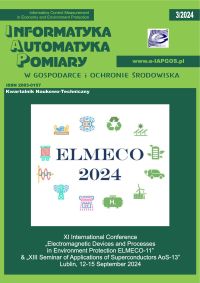TWORZENIE WYSOCE WYSPECJALIZOWANYCH CHATBOTÓW DO ZAAWANSOWANEGO WYSZUKIWANIA
Andrii Yarovyi
Vinnytsia National Technical University, Department for Computer Science (Ukraina)
https://orcid.org/0000-0002-6668-2425
Dmytro Kudriavtsev
dmytro_k@vntu.edu.uaVinnytsia National Technical University, Department for Computer Science (Ukraina)
https://orcid.org/0000-0001-7116-7869
Abstrakt
W tym badaniu przedstawiono tworzenie wysoce wyspecjalizowanych chatbotów. Zwrócono uwagę na wpływ wielowątkowego wyszukiwania obszarów tematycznych. Zdefiniowano wykorzystanie powiązanych obszarów tematycznych w analizie tekstu chatbota. Na przykładzie inteligentnego chatbota odnotowano zalety korzystania z wielu powiązanych obszarów tematycznych.
Słowa kluczowe:
przetwarzanie tekstu, inteligentna analiza danych, chatbot, zaawansowane wyszukiwanieBibliografia
Agarwal S., Rahul P., Neetu: New Text Detection Technique Using Machine Learning Architecture. Dwivedi S., Singh S., Tiwari M., Shrivastava A. (eds): Flexible Electronics for Electric Vehicles. Lecture Notes in Electrical Engineering 863. Springer, Singapore, 2023 [https://doi.org/10.1007/978-981-19-0588-9_1].
Google Scholar
Arkoudas K.: ChatGPT is no Stochastic Parrot. But it also Claims that 1 is Greater than 1. Philos. Technol. 36(54), 2023 [https://doi.org/10.1007/s13347-023-00619-6A].
Google Scholar
Cao Y., Xu G., Gao Y., Song C.: Application of natural language processing technology based on TensorFlow framework in text mining and discovery algorithm. IET Communications 17, 2022 [https://doi.org/10.1049/cmu2.12534].
Google Scholar
Chen W. et al.: Improved Recurrent Neural Networks for Text Classification and Dynamic Sylvester Equation Solving. Neural Process Lett 55, 2023, 8755–8784 [https://doi.org/10.1007/s11063-023-11176-6Raj].
Google Scholar
Greco C. M., Tagarelli A.: Bringing order into the realm of Transformer-based language models for artificial intelligence and law. Artif Intell Law 2023) [https://doi.org/10.1007/s10506-023-09374-7].
Google Scholar
Henrickson L., Meroño-Peñuela A.: Prompting meaning: a hermeneutic approach to optimising prompt engineering with ChatGPT. AI & Soc 2023 [https://doi.org/10.1007/s00146-023-01752-8].
Google Scholar
Joseph J. F. J., Nonsiri S., Monsakul A.: Keras and TensorFlow: A Hands-On Experience. Prakash K. B., Kannan R., Alexander S., Kanagachidambaresan G. R. (eds): Advanced Deep Learning for Engineers and Scientists. EAI/Springer Innovations in Communication and Computing. Springer, Cham. 2021 [https://doi.org/10.1007/978-3-030-66519-7_4].
Google Scholar
Karchi R. P., Hatture S. M., Tushar T. S., Prathibha B. N.: AI-Enabled Sustainable Development: An Intelligent Interactive Quotes Chatbot System Utilizing IoT and ML. Whig P., Silva N., Elngar A. A., Aneja N., Sharma P. (eds): Sustainable Development through Machine Learning, AI and IoT. ICSD 2023. Communications in Computer and Information Science 1939. Springer, Cham. [https://doi.org/10.1007/978-3-031-47055-4_17].
Google Scholar
Kvyetnyy R., Ivanchuk Y., Yarovyi A., Horobets Y.: Algorithm for Increasing the Stability Level of Cryptosystems. Selected Papers of the VIII International Scientific Conference “Information Technology and Implementation" – IT&I-2021, 293–301.
Google Scholar
Meyer J. G. et al.: ChatGPT and large language models in academia: opportunities and challenges. BioData Mining 16(20), 2023 [https://doi.org/10.1186/s13040-023-00339-9].
Google Scholar
Mondal B.: Best 25 Datasets for NLP Projects. Kaggle [https://www.kaggle.com/discussions/general/150720] (avaible 13.05.2020).
Google Scholar
Pallis George, Trihinas D., Tryfonos A., Dikaiakos M.: DevOps as a Service: Pushing the Boundaries of Microservice Adoption. IEEE Internet Computing 22, 2018, 65–71 [https://doi.org/10.1109/MIC.2018.032501519].
Google Scholar
Raj A., Jasmine K.: Building Microservices with Docker Compose. The International Journal of Analytical and Experimental Modal Analysis XIII, 2021, 1215.
Google Scholar
Siad S. M.: The Promise and Perils of Google's Bard for Scientific Research. AI. 2023 [https://doi.org/10.17613/yb4n-mc79].
Google Scholar
Thapa S., Adhikari S.: ChatGPT, Bard, and Large Language Models for Biomedical Research: Opportunities and Pitfalls. Ann Biomed Eng 51, 2023, 2647–2651 [https://doi.org/10.1007/s10439-023-03284-0].
Google Scholar
Yarovyi A. et al.: Information technology in creating intelligent chatbots. Proc. SPIE 11176, 2019, 1117627 [https://doi.org/10.1117/12.2537415].
Google Scholar
Yarovyi A., Kudriavtsev D.: Dictionary data structure for a text analysis task using cross-references. IEEE 17th International Conference on Computer Sciences and Information Technologies – CSIT, 2022, 61–64 [https://doi.org/10.1109/CSIT56902.2022.10000460].
Google Scholar
Yarovyi A., Kudriavtsev D.: Method of multi-purpose text analysis based on a combination of knowledge bases for intelligent chatbot. CEUR Workshop Proceedings 2870, 2021, 1238–1248.
Google Scholar
Autorzy
Andrii YarovyiVinnytsia National Technical University, Department for Computer Science Ukraina
https://orcid.org/0000-0002-6668-2425
Head of Department for Computer Science of Vinnytsia National Technical University (Ukraine).
Author of more than 100 technical articles (29 Scopus indexed articles),
5 monographs, 2 patents.
Autorzy
Dmytro Kudriavtsevdmytro_k@vntu.edu.ua
Vinnytsia National Technical University, Department for Computer Science Ukraina
https://orcid.org/0000-0001-7116-7869
Statystyki
Abstract views: 103PDF downloads: 97
Inne teksty tego samego autora
- Serge Ageyev, Andrii Yarovyi, INTELIGENTNY WÓZEK INWALIDZKI Z NAPĘDEM ELEKTRYCZNYM: PROBLEMY I WYZWANIA W PODEJŚCIU PRODUKTOWYM , Informatyka, Automatyka, Pomiary w Gospodarce i Ochronie Środowiska: Tom 11 Nr 3 (2021)









